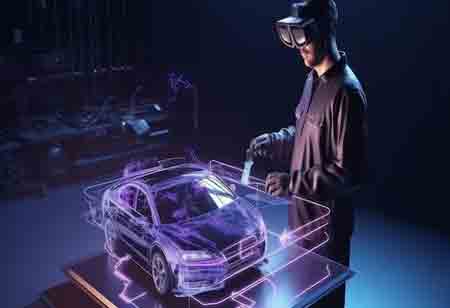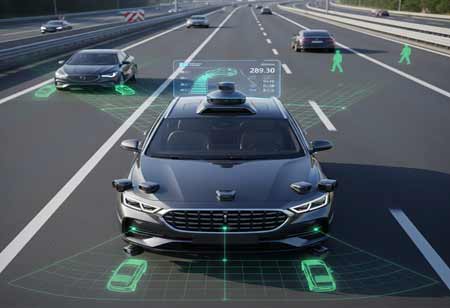THANK YOU FOR SUBSCRIBING
THANK YOU FOR SUBSCRIBING
Be first to read the latest tech news, Industry Leader's Insights, and CIO interviews of medium and large enterprises exclusively from Auto Tech Outlook

By
Auto Tech Outlook | Wednesday, September 10, 2025
Stay ahead of the industry with exclusive feature stories on the top companies, expert insights and the latest news delivered straight to your inbox. Subscribe today.
Automotive vehicle coverage solutions are entering a dynamic phase of transformation driven by evolving transportation technologies, shifting consumer expectations, and increasingly complex mobility ecosystems. The advancement of electric vehicles, autonomous systems, and shared mobility services has introduced new vehicle ownership and use dimensions, prompting insurers to rethink traditional models.
At the same time, digitalization and data-driven tools are reshaping how coverage is designed, delivered, and managed. As vehicle functionality and user behavior become more sophisticated, the role of insurance in ensuring safety, security, and financial protection has grown more intricate.
Adapting to Evolving Expectations in Vehicle Coverage
The automotive vehicle coverage landscape is evolving significantly, shaped by changing consumer behavior, advancements in vehicle technology, and the emergence of flexible mobility solutions. Traditional insurance models are being restructured to accommodate the growing prevalence of electric vehicles, autonomous driving systems, and usage-based driving habits. Consumers seek personalized, transparent, responsive coverage options for their driving patterns and ownership models. This shift pushes insurers to explore dynamic coverage models that align premiums with real-time vehicle usage, condition, and risk exposure.
Integrating telematics and connected car technologies has enabled insurers to access granular driving data, allowing for more accurate risk assessment and fairer pricing. The shift toward shared mobility, such as ride-hailing and car subscription services, has introduced new forms of liability and necessitated tailored coverage frameworks. Policies are now being designed for vehicle owners, occasional users, and multiple-party arrangements, reflecting the flexible nature of modern transportation.
Digital platforms are becoming central to how customers interact with coverage providers. From mobile-first claim filing systems to AI-powered support chat, convenience and immediacy are now integral to service delivery. These advancements indicate a broader transformation in the automotive vehicle coverage sector, emphasizing personalization, automation, and consumer empowerment.
Addressing Industry Hurdles with Innovative Approaches
Despite considerable progress, the automotive vehicle coverage sector faces several structural and operational challenges that require targeted solutions. One recurring issue is the complexity of underwriting emerging vehicle technologies, particularly electric and autonomous vehicles. These vehicles have new risk profiles due to their sophisticated software systems, battery components, and sensor reliance. In response, insurers collaborate with automotive experts to refine actuarial models and integrate real-time diagnostics into coverage evaluation. This approach improves pricing accuracy and aligns protection levels with actual operational risk.
Another challenge involves managing fraudulent claims, which can significantly increase operational costs and disrupt the claims ecosystem. To combat this, insurance providers are deploying AI-based fraud detection tools that analyze patterns across claims data to flag anomalies. Combined with blockchain technology to ensure transaction transparency, these tools reinforce trust and efficiency within the system.
Climate-related events also pose increasing challenges to vehicle coverage. Natural disasters such as hailstorms, floods, and wildfires can lead to spikes in claims, impacting solvency and customer satisfaction. Insurers address this by developing geo-specific coverage plans and offering optional add-ons tailored to high-risk areas. Advanced weather modeling tools are also being integrated into underwriting processes to anticipate risk more accurately.
Consumer understanding of policy terms often presents a barrier to satisfaction and retention. Complex jargon and opaque conditions can lead to misinterpretation during claims. Coverage providers simplify documentation, incorporate visual policy breakdowns, and offer multilingual digital guides to mitigate this. These changes enhance comprehension and help policyholders make informed decisions.
Another critical area is the protection of customer data, mainly as vehicle coverage increasingly relies on connected car data. Adopting end-to-end encryption, consent-based data-sharing models and compliance-focused cybersecurity protocols ensures that consumer privacy is respected while allowing enhanced service personalization.
Unlocking Value through Innovation and Integration
The automotive vehicle coverage industry presents considerable opportunities for innovation that benefit stakeholders across the ecosystem, including consumers, insurers, automakers, and technology providers. One of the most transformative developments is the expansion of usage-based insurance (UBI). UBI models use telematics to monitor driving behavior, including speed, braking, and mileage, allowing insurers to offer personalized premiums. This rewards safe driving and encourages responsible vehicle use, fostering a more efficient and equitable insurance landscape.
Another promising advancement is the integration of insurance offerings directly within the vehicle purchase or leasing process. Embedded insurance simplifies the customer journey by bundling coverage with the vehicle, reducing the need for separate transactions. This approach benefits dealers, manufacturers, and insurers by creating streamlined onboarding and enhanced customer retention.
Artificial intelligence is leveraged beyond fraud detection and customer service with new claims automation and predictive maintenance applications. Smart algorithms can process accident reports and assess vehicle damage through image recognition, expediting claims approvals. Predictive tools also analyze wear and tear data to alert drivers and insurers to potential issues, supporting proactive maintenance and reducing downtime.
Electric vehicles (EVs) are creating new niches within the coverage market. EV-specific insurance products that consider battery health, charging behavior, and replacement costs are emerging. Some providers offer tiered coverage options linked to battery longevity and performance benchmarks. These tailored products are helping close the protection gap for EV owners and encourage further clean mobility adoption.
 Copyright © 2025 AutoTech Outlook. All Rights Reserved | Privacy Policy | Subscribe | Sitemap | About us | Feedback Policy | Editorial Policy
Copyright © 2025 AutoTech Outlook. All Rights Reserved | Privacy Policy | Subscribe | Sitemap | About us | Feedback Policy | Editorial Policy 



